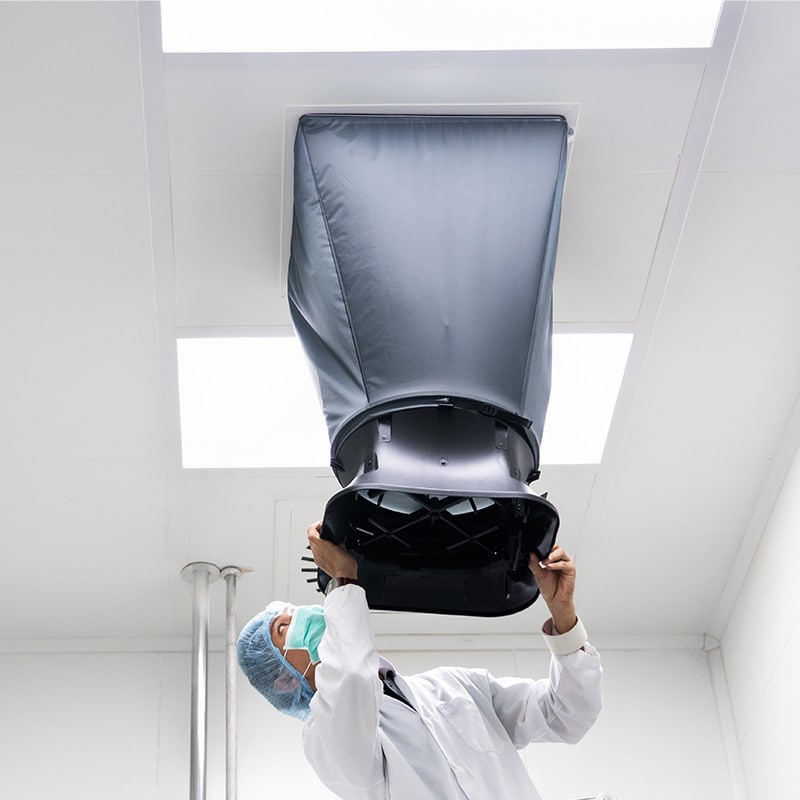
Calibration
Our comprehensive range of industry-leading calibration services includes an extensive list of on-site and laboratory-based instruments and equipment
READ MORE

Pharmaceutical and healthcare specialist service provider

Detailed, multi-parameter testing

Prompt results and comprehensive reporting

Out-of-hours monitoring and permanent monitoring systems
Health and Safety is always at the forefront of all we do at Intech, we understand the importance of environmental safety monitoring and the implementation of safeguarding systems to help prevent and mitigate risk. We offer installation, operational and qualitative testing for an extensive range of Gas Detection systems throughout the United Kingdom. Our planned preventative maintenance (PPM) program ensures that periodic function tests (Bump Tests) and Calibration Tests are completed and documented to industry standards.

Calibrating your gas detection system is crucial for maintaining the accuracy, functionality, and safety of your meter, and ensuring compliance with relevant industry standards.
On average Sensors may experience a drift in calibration ranging from less than 2% to nearly 5% over a short period of time, influenced by factors such as usage, temperature, humidity, exposure to contaminants, high gas levels, and the effects of aging or physical shock.
It is advisable to calibrate these devices regularly, ideally every 3, 6, and 12 months intervals, to guarantee not only precision but also safety, ensuring that alarms are activated in the event of gas exposure.
The calibration process consists of two steps: first, the detector is adjusted to zero in an environment that simulates “clean air.”
Following this, the detector is exposed to calibration gases with known concentrations of the target gas.
Any discrepancies from the expected results are then rectified.
With increasing regulatory demands for stringent gas detection calibration protocols and the necessity for systemic bump testing, the availability of test gas has become essential. Gas detectors are vital for the safety of personnel and facilities, making it imperative that this equipment remains operational.
Gas hazards are found in all types of business and industries and can be categorized into three main categories:
| GAS | TLV | STEL | IDLH |
| H2S (Hydrogen sulfide) | 10 PPM | 15 PPM | 33 PPM* |
| Cl2 (Chlorine) | 0.5 PPM | 01 PPM | 10 PPM |
| NH3 (Ammonia) | 25 PPM | 35 PPM | 100 PPM |
| CO (Carbon monoxide) | 25 PPM | 400 PPM | 1500 PPM |
| SO2 (Sulfur dioxide) | 02 PPM | 05 PPM | 100 PPM |
| TVL | Threshold Limit Value | The TLV for chemical substances is defined as a concentration in air, typically for inhalation or skin exposure. Its units are measured in parts per million (ppm) for gases and in milligrams per cubic meter (mg/m3) for particulates such as dust, smoke and mist. |
| STEL | Short-term Exposure Limit | A short-term exposure limit (STEL) is the acceptable average exposure level over a short period of time, usually recorded within 5 minutes if the time weighted average is not exceeded. |
| IDLH | Immediately Dangerous to Life and Health | The term immediately dangerous to life or health (IDLH) is the limit set for no exposure, as airborne contaminants are “likely to cause death or immediate or delayed permanent adverse health effects or prevent escape from such an environment. |
We were pleased to discover that Intech could take care of IAQ testing for us along with the calibration of our FMS. The report was far more detailed than our previous provider and we were pleased to find that the format of the report was similar to other documentation sent to us by Intech. Such a simple thing can make document review easier.
Pharmaceutical product distributor
What we do
